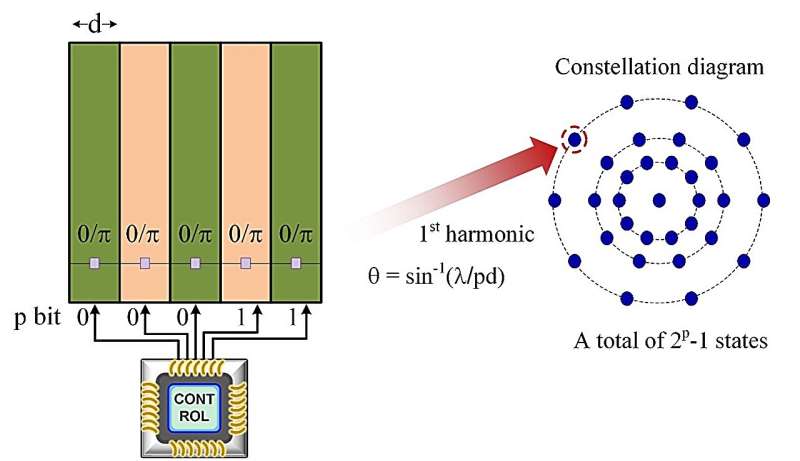In recent years, electronics engineers worldwide have been trying to develop new hardware that could further boost the speed and efficiency of wireless communications. Digitally programmable metasurfaces, advanced artificial materials engineered to manipulate the properties of electromagnetic waves, have been found to be particularly promising for the transmission of wireless data.
A key advantage of these artificial materials is that they could transmit wireless data more efficiently, without relying on conventional digital-to-analog conversion processes. Despite their potential, many metasurface-based antennas have so far achieved underwhelming results, such as low data transmission rates and poor information mapping efficiencies.
Researchers at Southeast University, Nanyang Technological University and other institutes recently developed a new programmable metasurface that could overcome these limitations, attaining remarkable information mapping efficiencies. This antenna, introduced in a paper published in Nature Electronics, could contribute to the future advancement of wireless communication technology.
“In previous works, we developed several programmable metasurface-based communication schemes,” Tie Jun Cui, senior author of the paper, told Tech Xplore. “However, in these works, for encoding information that is modulated into the metasurface, the amount of information that can be retrieved from a single measurement is not sufficiently high, which diminishes the communication speed and capacity of the system.”
The main goal of the recent study by Cui and his colleagues was to devise an optimal scheme to efficiently retrieve and map programmable patterns to the data transmitted by a metasurface-based antenna. Their work builds on one of their earlier studies, which analyzed the symmetric features of the far-field responses of a spatiotemporal metasurface at the temporal harmonics.
“In this work, we shifted our focus to spatial harmonics,” said Cui. “Through careful mathematical formulation, we discovered that using the 1-bit encoding sequences with the length on an odd prime, the produced constellation diagram at the direction of the 1st harmonic exhibits distinctiveness and symmetry that can be used to achieve the highest information mapping efficiency.”
As part of their new study, Cui and his colleagues set out to assess the optimal information mapping scheme they previously identified, using a newly fabricated programmable metasurface antenna. The antenna they created is based on a printed circuit board (PCB) that consists of three metallic layers and two substrate layers.
“The top metallic layer contains the patch antenna array, the middle layer serves as the ground plane, and the bottom layer includes the phase shifter module, which controls the phase states of each column,” explained Cui. “The central five columns of radiators are excited by an incident wave, while four columns of radiators at the outside are dummy elements, introduced to better match the same boundary conditions for the central five columns of radiators.”

The phase response of each radiator column in the team’s antenna is tuned by a switchable delay line structure. This structure contains four diodes that can control the effective length of the delay line, switching between a 0 or π phase modulation.
“For each p-bit encoding pattern modulated into the programmable metasurface, the metasurface antenna will generate a corresponding radiation pattern,” said Cui. “Out of the 2p possible patterns, 2p-1 exhibit symmetric and distinctive far-field responses in the direction of the first harmonic. Consequently, one can retrieve nearly all the information of the encoding pattern by performing a single far-field measurement of the complex amplitude at this specific direction.”
The metasurface antenna design introduced by the researchers has several advantages over previous metasurface-based solutions for wireless communication. Most notably, it allows the modulation of information to be completed by the antenna directly, without the need for additional modules (e.g., I/Q channels or mixers).
Another advantage of the team’s scheme is that it enables the retrieval of almost all encoding patterns from a single measurement. This in turn significantly boosts the antenna’s information mapping efficiently, pushing it close to unity (i.e., near its maximum possible efficiency).
The proposed scheme offers several advantages. First, information modulation is achieved directly by the programmable metasurface antenna, without requiring additional modules such as I/Q channels or mixers. Second, almost all the encoding patterns can be retrieved from a single measurement, resulting in an information mapping efficiency that is close to unity.
“We discovered an optimal information mapping scheme based on the programmable metasurface that enables the retrieval of nearly all metasurface encoding patterns from a single far-field measurement, reaching the information mapping limit,” said Cui. “A promising practical application of this study is to realize high-speed and high-capacity wireless communications based on programmable metasurfaces by adopting our information mapping scheme.”
The programmable metasurface developed by this research team and the scheme underlying its operation could open new possibilities for the development of more advanced communication technologies. In their next studies, Cui and his colleagues are hoping to use their proposed approach to develop other promising transmitters for wireless communication.
“Our future research plans include developing practical, programmable metasurface-based transmitters using our scheme, exploring the possibility of extending our theory to two dimensions, and investigating more schemes to enable programmable metasurface based high speed and high-capacity wireless networks,” added Cui.
More information:
Haotian Wu et al, A programmable metasurface antenna that approaches the wireless information mapping limit, Nature Electronics (2025). DOI: 10.1038/s41928-024-01298-7
© 2025 Science X Network
Citation:
Programmable metasurface antenna exhibits remarkable wireless information mapping efficiency (2025, January 17)
retrieved 17 January 2025
from https://techxplore.com/news/2025-01-programmable-metasurface-antenna-remarkable-wireless.html
This document is subject to copyright. Apart from any fair dealing for the purpose of private study or research, no
part may be reproduced without the written permission. The content is provided for information purposes only.

